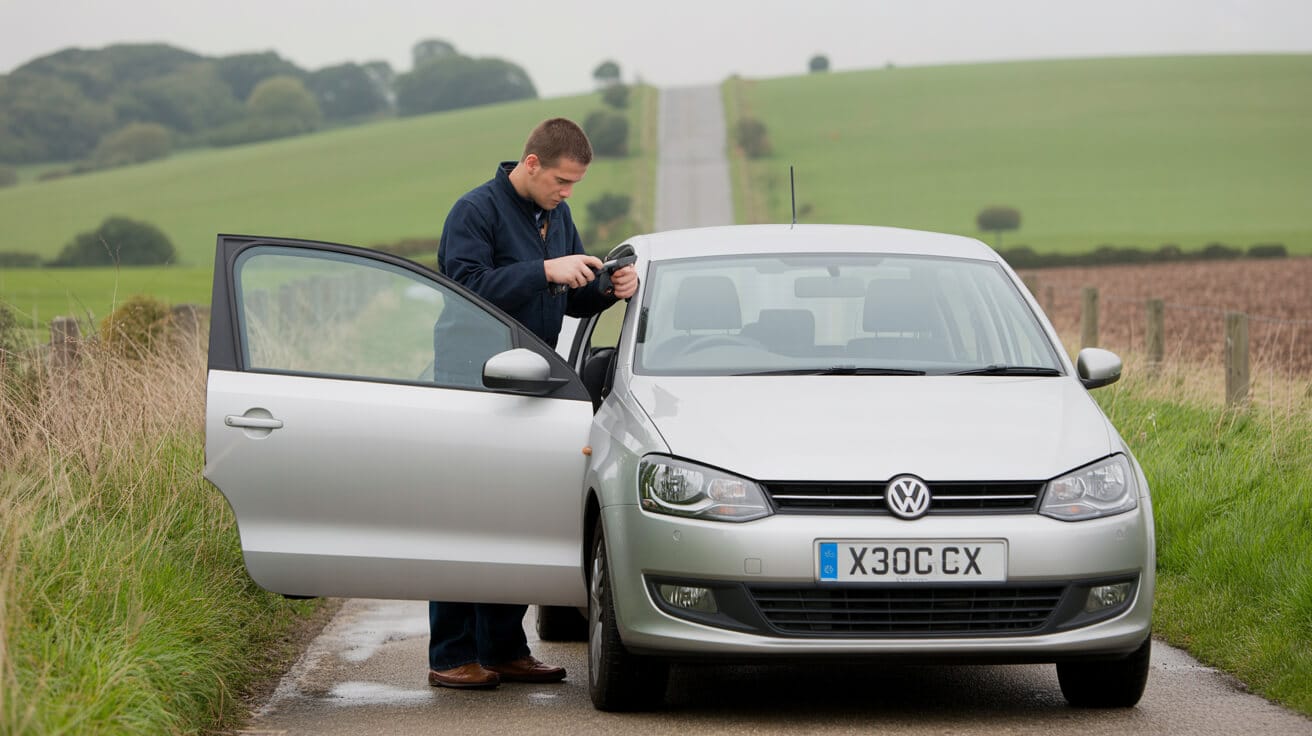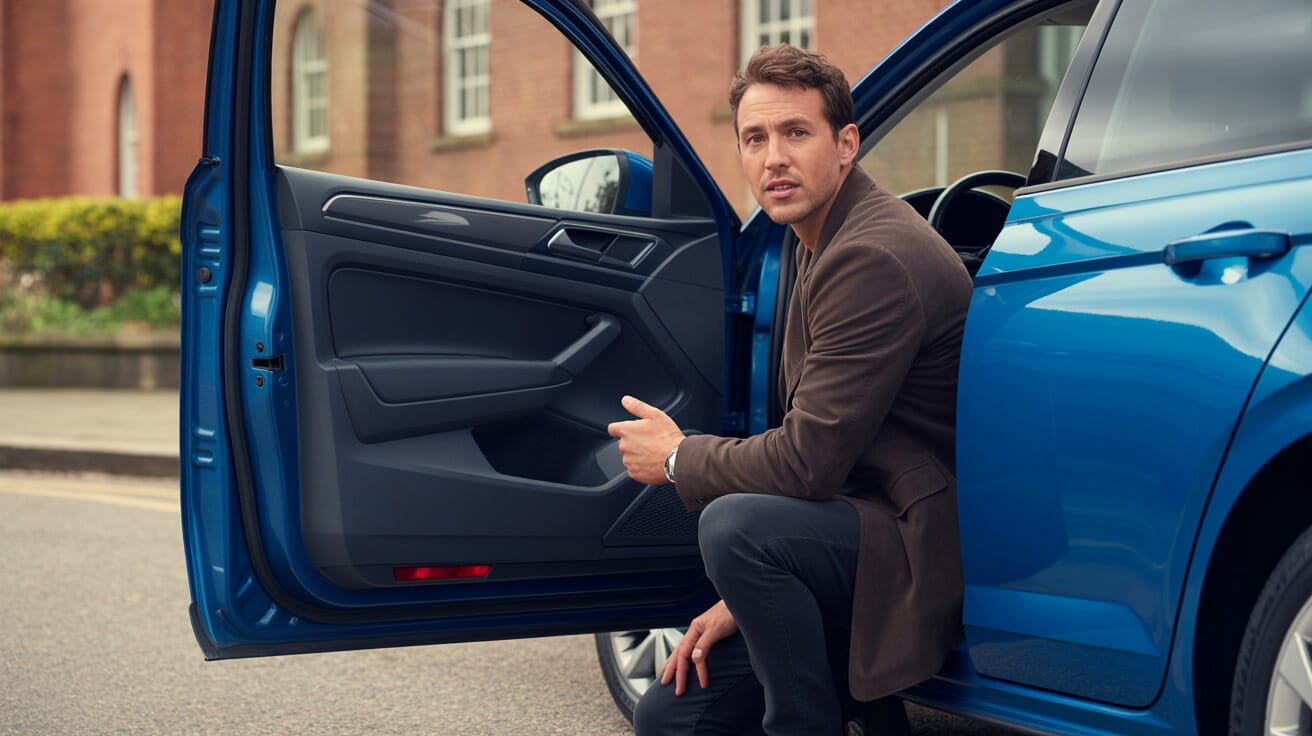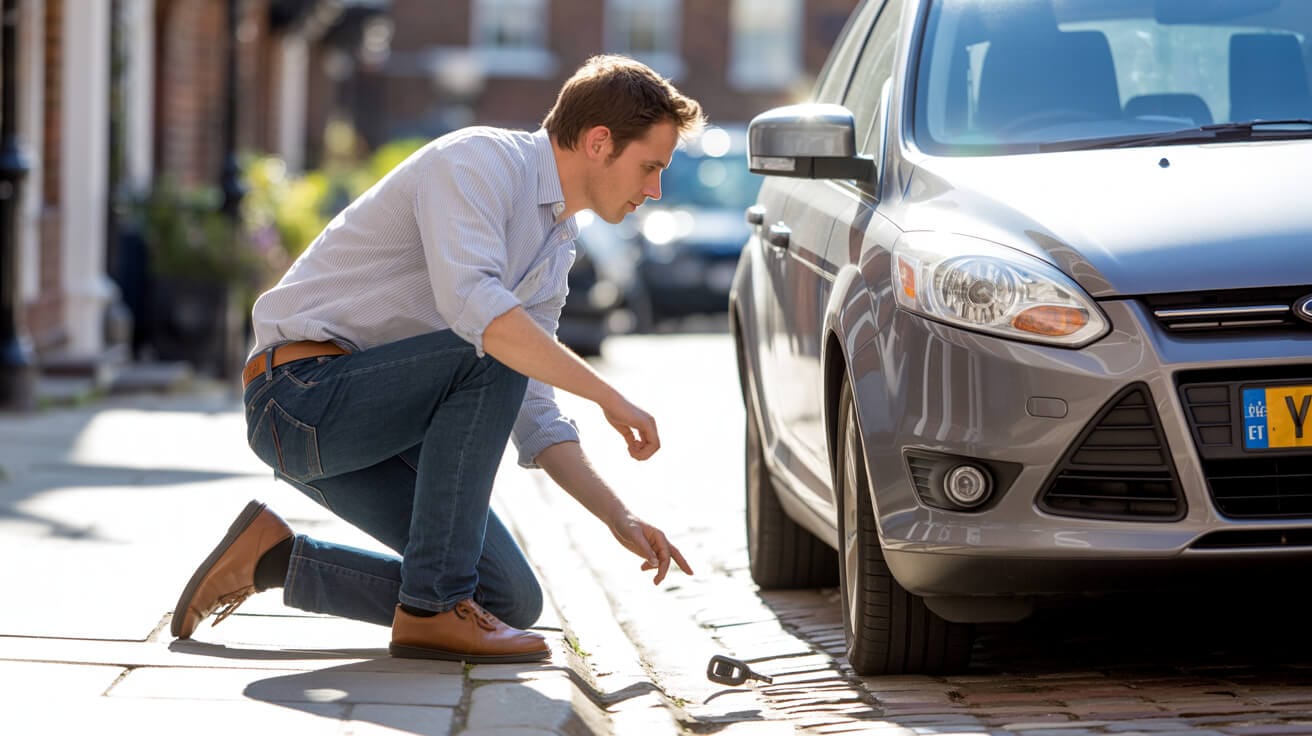Why Is My Car Key Suddenly Not Working?
When your car key quits, it’s more than an inconvenience—it’s a spike of frustration and lost time. Before you reach for the phone, know this: Many common issues have simple, do-it-yourself checks that get you back on the road fast and cost nothing but a bit of patience.
For most modern vehicles, key failure traces back to a handful of culprits: key wear, battery drain, harsh weather, or electronic gremlins. Addressing the basics first spares you the hassle of a wasted call and can often resolve the fault in minutes.
Sometimes, what looks like failure is just a detail out of place—pause and use your eyes and hands before you panic.
What Obvious Signs Should I Look For?
Start with what you can see and feel. Examine the key blade for bends, chips, or worn-out edges—any deformation can stop it fitting or turning smoothly. If your car uses a remote fob, check whether the buttons feel sticky, worn, or unresponsive.
Test your spare key: If both struggle, the problem is likely in your locks or the car itself, not the key. Cycle through each lock on the vehicle—driver’s door, passenger, boot, and ignition if present. Debris or ice in a cylinder, swollen doors from weather, or trims out of alignment trip up even a perfect key.
- Bent/damaged key blade: Won’t insert/turn without sticking or resistance.
- Sticky or stiff door handles: May hint at linkage or cylinder issues.
- Visible dirt, corrosion, or ice: Gently clear with a non-conductive tool and avoid force.
For electronic keys, open the fob (most snap open with a small coin) and check the battery; a loose fit or corrosion is an instant red flag.
What’s the First Step If the Key Fails?
- Inspect both key and lock for visible flaws.
- Try your spare key everywhere—consistent failure means look beyond the key.
- Remove debris with a soft brush or air puffer—avoid sharp objects.
- Refrain from forcing the key; escalating force risks a snapped blade or broken lock.
- For remote fobs, reseat or change the battery, ensuring contacts are clean and firm.
Act with care and you’ll avoid the most costly rookie mistakes.
Every car owner is an investigator—the fix is often in the detail you almost missed.
Is My Key Fob or Remote the Source of the Problem?

Many modern vehicles depend entirely on remote keys or fobs, relying on batteries, microchips, and radio signals. A single dead coin cell or worn contact in the fob derails everything—often before you see warning lights or error messages.
Symptoms like reduced range, inconsistent unlocking, or buttons needing extra pressure usually point to your remote itself, rather than the car.
How Do I Test My Key Fob?
Check for the fob’s red LED flash—if absent, your battery is likely dead. Press each button in turn; if some work but not others, the issue is internal (contacts/switches), while total silence with fresh batteries may indicate fob failure or programming loss.
Try holding the fob closer to the car—if range drops or only works from a metre away, swap the battery, making sure to replace it with the correct type (often CR2032 or CR2450, as your manual details).
If you have a spare remote or card, test it before assuming a bigger fault. When neither works, move your focus to the car’s receiver or antenna.
What If Only the Remote Fails but the Mechanical Key Works?
- Mechanical key unlocks, remote doesn’t: Nearly always a battery or contact in the fob.
- Remote works intermittently: Potential low battery, environmental interference, or contact wear.
- Remote completely inert; spare works: Replace or reprogram the faulty fob—resist the urge to keep “trying” as repeated failed attempts can sometimes trigger deeper electronic blocks in anti-theft systems.
A working spare is gold—test everything before you call in help.
A fob out of battery is not a car beyond hope—a simple swap can be the fix.
Does the Problem Lie With the Car’s Battery or Electrical Supply?

A weak car battery stakes its claim in subtle ways: dim cabin lighting, slow central locking, or a lazy starter motor. Many confused owners waste time blaming keys or fobs when their car’s main power is the culprit all along.
Coin cell batteries in remotes last 1–3 years; car batteries average 4–6, but both fail sooner under harsh use or climate extremes.
What Quick Power Checks Solve Most Key Issues?
- Watch for interior lights flickering, dash lights glitching, or weak central locking. If these occur, suspect your main battery.
- Test remote range: if it drops, replace the coin cell.
- Use a voltmeter: a healthy battery reads over 12.4 volts resting.
- Try the spare fob or key—scratchy, low-energy responses suggest battery, not security, problems.
| Symptom | First Check | DIY Fix |
|---|---|---|
| Dim lights, weak starter | Car battery voltage | Jump/replace battery |
| Remote weak, car fine | Fob coin cell | Replace battery |
| No click, both keys dead | System power/immobil | Seek expert help |
Don’t ignore small warnings—sorting battery issues fast can prevent a day-ruining lockout.
An old battery impersonates a broken car—resolve doubts before you escalate.
Could the Security or Deadlock System Be the Roadblock?

Modern vehicles excel at keeping out the wrong people—occasionally by keeping you out as well. Electronic deadlocks, security modes, and “sleep” states block key and fob alike, especially after multiple failed attempts or if the car senses suspicious activity.
Dashboard padlock icons, blinking key lights, or repeated refusal when doors should unlock all point to system-enforced locks.
Which Security Features Cause Key Lockout Frustration?
- Double-locking (deadlock): Requires two remote presses or a deliberate sequence to unlock.
- Sleep/proximity lock: The car ignites security mode after a timeout, especially on push-button “smart” keys.
- Anti-tamper after failed unlocks: Some cars shut down fob response if too many wrong codes are sent.
A short wait (2–10 minutes) often resets these systems. Walk away from the vehicle, lock it, wait, then return and retry. Be gentle—repeated frantic pressing can deepen the lockout.
How Do I Spot a Security Lockout and What’s Safe to Try?
- Check for warning symbols or lights on the dashboard.
- Try both keys/fobs, allowing two to three minutes between attempts.
- Listen for changes: repeated double-clicks or new beeps suggest activated deadlock or alarm triggers.
- If the immobiliser light doesn’t go out when the key is in or near its dock, don’t attempt further programming without guidance.
Security lockouts are not always signs of hardware failure—a pause and methodical retry may clear the issue.
Your car’s defences act with blunt force—let patience outthink panic.
Could an Electronic Control Module or Antenna Be at Fault?

Electronic modules manage almost everything in late-model cars—from keyless entry to start authorisation. When failure creeps into relays, antennas, or “gateway” controllers, the symptoms multiply—locks become fickle, windows quit, sensors sleep.
These require a calm, precise approach—rushing in with off-the-shelf gadgets or guesswork can multiply costs and erase records needed for warranty or insurance.
What Signs Flag a Genuine Electronic Fault?
Persistent immobiliser or padlock lights, failure of multiple electric features, or a total absence of fob response when batteries are fresh—these suggest module, relay, or antenna failure, especially in cars with advanced electronic locks or start buttons.
If both spare and main fobs fail, and physical keys don’t help, check if other electric controls (windows, mirrors, horn) work. If not, the problem is almost certainly deeper than the key—pause before making changes.
What Not to Touch Without Professional Gear
- Never attempt a module “reset” or key programming online unless you know the module type and your system’s compliance.
- Avoid online “force start” hacks—these risk permanent lockout or data wipes.
- Never short-connect, bridge sockets, or interfere with OBD2 ports without proof of authorisation and equipment suited to your make.
Reliable fixes at this level require job logs, photos, and warranty-friendly action—hand the situation off to trained hands.
In complex systems, the smart move is often knowing the repair isn’t yours to make.
What Should I Prepare Before Contacting a Locksmith?

Professional auto locksmiths—like those at Autolocks Ltd—operate in a world of compliance: owner verification, data privacy, and strict documentation. The more you prepare, the faster and more secure your repair.
You want to be ready to prove ownership, understand the process, and know what to expect at every step.
How Can I Make the Service Visit Smoother and Safer?
Gather these essentials before you call:
- Photo ID: (licence or passport)
- Proof of vehicle ownership: (V5C, lease agreement)
- Spare key/fob: if available
- Note of symptoms and steps you’ve tried
Request a clear, written quote and ask for the expected SLA (service level agreement)—standard jobs often resolve same-day, emergencies within the hour.
Onsite, always check ID and insurance of your locksmith, review each step of work, and confirm every action—key cut, programme, or test—gets logged. Consent and record-keeping keep your car and data under your control.
What Secure Service Process Should I Expect?
A trusted locksmith will:
- Re-validate your ID and ownership on arrival.
- Walk you through the job scope, highlighting all risks, costs, and alternatives.
- Use non-destructive entry techniques first, documenting with photos.
- Complete every key coding or programming process with job logs and photo proof.
- Demonstrate lock, unlock, start, and alarm—all before handover.
- Provide aftercare tips and warranty or review details.
If any step sounds rushed, unclear, or skips documentation, pause and clarify. Professionals understand your right to full transparency.
Control is peace of mind—never relinquish it without seeing the evidence.
What Common Mistakes Push Car Key Problems from Bad to Worse?

Rushed DIY “fixes” and shortcuts are a leading cause of avoidable expense. Simple respect for systems and procedure not only keeps you legal, but also preserves warranties and options for painless future claims or insurance.
Which Pitfalls Cost Owners Most Money?
- Spraying oil or non-auto lubricants into locks: these attract dirt and can clog mechanisms.
- Repeated forced entry attempts: causing snapped keys or damaged cylinders.
- Following online “bypass” hacks: many require questionable software, risking immobiliser lockout or warranty loss.
- Trying more than one company simultaneously: this leads to competing logs or voided aftercare.
- Skipping proper docs and photo trail: undermines your position if you ever claim on warranty or insurance.
Each error closes a door, sometimes literally and often at your expense.
Opportunity is preserved by patience and process—don’t trade peace for speed.
When Is Expert Help Unavoidable—and How Do I Choose the Right Locksmith?

Some issues—deep security, digital key failure, or likely module/signal faults—need a professional, full stop. Rely on experience, not a logo; ask direct questions and expect full answers.
The best locksmiths—like those at Autolocks Ltd—bring accredited skill, legitimate tools, and a traceable process tailored to your make and model.
What Standards Ensure Your Car and Data Are Safe?
- Full mobile coverage: Can reach your location with the right parts and skills.
- Written quote & SLA: Set clear cost and timing expectations.
- Proper ID & insurance shown on arrival: Protects you—and your warranty.
- Complete job documentation: Every action is logged for your record.
- Demonstrated aftercare: A walkthrough of new keys or digital features, plus clear instructions and warranty info.
Step-by-Step: Vetting a Professional Locksmith
- Confirm your make/model is supported and the van holds the right stock.
- Secure a written quote and timeline.
- Check credentials—ID, insurance, and qualifications.
- Watch the full job demo—unlock, start, and alarm—before signing off.
- Receive documented proof—job logs, photos, aftercare notes.
With smart/digital keys, clarify data handling: your privacy and transparency come first.
Trust is measured after the work, not before—it’s earned in careful steps.
Choose Autolocks Ltd For Peace of Mind, Every Mile
Your car’s security, your data privacy, and your peace of mind deserve more than a rushed rescue. Autolocks Ltd offers certified, insured technicians with rapid response, advanced diagnostic tools, policy-compliant protocols, and full aftercare—delivered every time.
Trust your recovery and security to a team that proves itself at every step.
Choose Autolocks Ltd—when it’s more than just getting the door open, and when you want every moment accounted for.
Frequently Asked Questions
Why Has My Car Key Suddenly Failed—and What Should I Check First?
Car key failure can seem like a sudden disaster, but the true cause is rarely mysterious—most key faults have practical explanations you can troubleshoot yourself before calling for outside help. It’s easy to assume the worst, but mechanical wear, fob battery depletion, environmental factors, or minor electronic issues explain the majority of situations. Many of these are simple enough for you to spot and resolve at home.
The key to solving car entry trouble is rarely force—it’s sequence, care, and calm.
First Moves: Home Diagnostic Steps
- Check the Key Blade: Examine for bend, chip, rounded tip, or chrome flaking. If it won’t fit smoothly, avoid force.
- Test Remote Fob: Press each button; look for indicator light blink. No flash or response? Suspect the battery.
- Weather Watch: Sudden rain, frost, or morning dew can jam mechanisms or block buttons. Gently dry and try again.
- Spare Key Test: Always try a spare in all locks. One working and one not indicates key-specific, not vehicle-wide, trouble.
- Dashboard Signals: Look for battery or padlock icons. Modern systems can “sleep” or temporarily lock you out.
- Vehicle Battery: If the car appears “dead,” test main battery voltage (under 12.2V warrants recharge).
By isolating whether it’s the key, fob, or car at fault, you set yourself up to resolve issues swiftly or explain symptoms to a professional for efficient help. Clearing minor debris from locks with a soft brush, gently replacing a fob battery, and checking lighting or electrical response often reignites function—saving you time, stress, and money.
Getting methodical pays off: many drivers regain entry by following this sequence. If several methods fail, advance through the next focused step or consider preparing for a secure service call.
(Top search phrases: “car key not working UK”, “car key troubleshooting”, “key fob battery failed”)
The fix you find often waits at the smallest crack—if you pause to look.
- Inspect Key Blade and Casing: Search for bends, deep scratches, or break points around the shoulder.
- Button Responsiveness: Test each fob button for tactile feedback and indicator light—unresponsive means internal wear or battery issue.
- Open the Fob: Replace the coin cell (CR2032 or as specified), checking for clean terminals and correct polarity.
- Use Your Spare: If the spare works everywhere, set aside the faulty key for repair.
- Decontamination: Remove grit, salt, or ice with a soft brush—never force a key into a blocked lock.
- Avoid Aggressive Sprays: Household lubricants leave residues; specialist sprays or graphite are safer if recommended by your manufacturer.
If your spare works but the original does not, avoid further attempts—retire the faulty item to prevent lock or fob damage. Consistent issues with both keys suggest a deeper issue needing battery, security, or electronics attention. Gentle, methodical inspection preserves warranty, safety, and reputation protection. Every action sets the stage for a smoother professional fix if needed.
(Target SEO: “visual car key checks”, “car fob not working”, “car key inspection steps”)
Are Your Key Fob, Remote, or Their Batteries at Fault?
Most drivers are surprised by how often the fob or remote—not the physical key—explains lockouts. Fob batteries last 2–3 years but can drain faster in cold conditions or if you use remote start or proximity unlock features frequently. Immediate clues include fading button response, no indicator light, or the need to be right next to the vehicle for the system to recognise the key.
Sometimes replacing a coin cell upgrades your day more than any mechanic could.
- Test Button and Range: Press every fob button at various distances. Indifferent, dim, or short-range operation is a classic dying-battery giveaway.
- Swap the Battery: Replace with the precise coin cell type, minding polarity. Many modern cars “wake” better after a battery swap and with the fob held near the start button or door.
- Reset Ritual: Some systems demand a brief timeout—after swapping batteries, wait two minutes, then retry function at the antenna point.
- Spare Fob Comparison: If your backup fob works perfectly, swap batteries or repair the main. Both failing, even after new batteries, points to a vehicle side issue—proceed to electrical and security checks.
- Signs of Damage: Water ingress, broken solder joins, or button collapse call for professional repair or replacement (avoid online “fix kits” from questionable sources).
Act quickly, but with precision. Diagnosis here can mean the difference between flawless entry and a callout—often, a new battery and careful button sequence restores control and confidence immediately.
(SEO keyphrases: “key fob not working”, “replace car key battery”, “remote entry issues”)
How Do Power or Security Systems Knock Out Both Key and Fob Access?
When both physical and remote keys fail, the car itself is often signalling a deeper power, security, or control feature at work. Flat vehicle batteries, immobiliser timeouts, or deadlock/anti-theft protocols can all present as sudden, total lockout events. You’re not alone—these systems are designed to deter theft, not just frustrate owners.
To restore entry, sometimes your job is to wait, not act—trust the security cycle.
Power or Security Reset Strategy
- Power Check: Gauge dash icons, interior lights, and attempt horn use. Dim or no response? Check battery voltage—with under 12.2V, nothing “talks” to keys.
- Deadlock/Immobiliser Protocol: If the padlock icon blinks or the car fails to respond after multiple unlock tries, step away for 5–10 minutes. The system may reset itself, especially after a failed unlock, power loss, or post-battery swap.
- Retry with Both Keys: Restart attempt first with the main key/fob, then with spares, holding fob at recognised “start” or antenna spots as directed by your owner’s manual.
- Notice System Behaviour: If interior electronics (windows, mirrors) work but doors do not, focus on lock actuators. No electrical life at all implies battery or network module trouble.
Repeated lockouts, padlock icons that won’t clear, or system-wide “dead” status after user attempts are signs to halt and escalate to diagnostics—you avoid escalation of electronics lockout or data corruption by doing so.
(SEO targets: “car immobiliser troubleshooting”, “deadlock reset”, “car won’t unlock security”)
What Should You Prepare Before a Professional Locksmith Visit?
When your own checks don’t bring a fix, preparation gives you leverage, protects your warranty, and ensures the work happens safely, quickly, and above the law. Before the locksmith arrives, gather government photo ID, proof of ownership, and your spare keys/fobs. Note and photograph symptoms—like error icons, non-response, or battery swaps attempted—for efficient troubleshooting.
Evidence is your strongest tool—clarity now saves problems later.
Quick Prep List for Service Calls
- Photo ID and Proof of Ownership: Don’t skip—no reputable service will touch your car without these.
- Symptom Checklist: Written notes and smartphone photos (error messages, icon lights, previous panel/lock work).
- All Fobs/Keys at Hand: Diagnostic success rates soar with every original item present.
- Pre-Verify Provider: Ask for branded van arrival, staff uniform, insurance, and written quote. Confirm secure data record-keeping (encryption/retention policy).
- At Handover: Require a live demonstration of all configurations—lock, unlock, start, and alarm. Obtain a signed, dated receipt and details of aftercare or warranty window.
These steps protect you if issues reemerge and speed up service (some warranty and insurance claims require data that is only captured proactively). Your methodical prep is the best guarantee of a quick, high-integrity fix.
(SEO clusters: “prepare for auto locksmith”, “auto locksmith required documents UK”, “how to choose a car locksmith”)
When Is It Time to Call Autolocks Ltd—and What Guarantees Your Trust?
If you’ve worked through basics with no result, or you see blank dash icons, non-responsive electronics, or immobiliser/lock icons that won’t clear, a professional is essential. Autolocks Ltd brings insured, company-verified technicians, branded vans, and the authority to code, cut, and programme all major physical and digital key systems across the UK.
Our specialists cover everything from Ford to BMW—including advanced digital keys and app-linked cars—active 24/7 for emergencies. Every job is owner-verified, non-destructive first, and audit-trailed; all sessions are logged and encrypted, with written warranty and compliance. Fleet and private owners both get the same gold-standard response, including a demo, locked merchant record, and aftercare ready from the very first call.
What sets true professionals apart: your trust, documented at every step and safeguarded for the future.
To regain access, protect your warranty, and secure your data with real certainty, contact Autolocks Ltd for the UK’s highest standard in vehicle entry, key coding, and aftercare.







